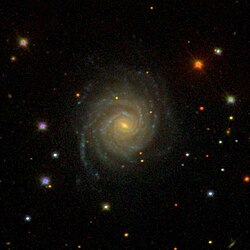NGC 1642
Appearance
| NGC 1642 | |
|---|---|
 The spiral galaxy NGC 1642. | |
| Observation data (J2000 epoch) | |
| Constellation | Taurus |
| Right ascension | 04h 42m 54.91s[1] |
| Declination | +00° 37′ 06.9″[1] |
| Redshift | 0.015419[1] |
| Heliocentric radial velocity | 4622 ± 0 km/s[1] |
| Distance | 220.1 ± 15.4 Mly (67.48 ± 4.72 Mpc)[1] |
| Apparent magnitude (V) | 12.6[1] |
| Characteristics | |
| Type | SA(rs)c[1] |
| Size | ~42,400 ly (13.01 kpc) (estimated)[1] |
| Apparent size (V) | 1.7' x 1.2'[1] |
| Other designations | |
| PGC 15867, UGC 3140, CGCG 393-073, MCG +00-12-072, 2MASX J04425489+0037070[1] | |
NGC 1642 is a spiral galaxy in the constellation of Taurus. Its velocity with respect to the cosmic microwave background is 4,575 ± 3 km/s, which corresponds to a Hubble distance of 67.5 ± 4.7 Mpc (∼220 million light-years).[1] It was discovered by German astronomer Heinrich d'Arrest on 29 December 1861.
One supernova has been observed in NGC 1642: SN 2023bhm (type Ia-91bg-like, mag. 18.1).[2]
NGC 1762 Group
[edit]According to A.M. Garcia, the galaxy NGC 1642 is part of the NGC 1762 group (also known as LGG 120) that includes at least 27 galaxies, including IC 392, NGC 1590, NGC 1633, NGC 1691, NGC 1713, NGC 1719, and NGC 1762, among others.[3]
See also
[edit]References
[edit]- ^ a b c d e f g h i j k "NASA/IPAC Extragalactic Database". Results for NGC 1642. Retrieved 28 July 2024.
- ^ Transient Name Server entry for SN 2023bhm. Retrieved 28 July 2024.
- ^ A.M. Garcia, "General study of group membership. II - Determination of nearby groups", Astronomy and Astrophysics Supplement Series, vol. 100 #1, July 1993, pp. 47-90 (Bibcode 1993A&AS.. 100...47G) Retrieved 28 July 2024.
External links
[edit] Media related to NGC 1642 at Wikimedia Commons
Media related to NGC 1642 at Wikimedia Commons- NGC 1642 on WikiSky: DSS2, SDSS, GALEX, IRAS, Hydrogen α, X-Ray, Astrophoto, Sky Map, Articles and images
